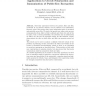121 search results - page 7 / 25 » Identity-based key agreement protocols from pairings |
ASIACRYPT
2007
Springer
14 years 1 months ago
2007
Springer
An extended abstract of this paper appears in Kaoru Kurosawa (Ed.): Advances in Cryptology ASIACRYPT 2007, volume 4833 of Lecture Notes in Computer Science, pages 265–282, Spring...
SCN
2010
Springer
13 years 5 months ago
2010
Springer
We introduce a protocol, that we call Human Key Agreement, that allows pairs of humans to establish a key in a (seemingly hopeless) case where no public-key infrastructure is avail...
CJ
2007
13 years 7 months ago
2007
In this paper we show that the group key agreement protocol proposed by Tseng suffers from a number of serious security vulnerabilities.
CRYPTO
2005
Springer
14 years 27 days ago
2005
Springer
Secret-key agreement between two parties Alice and Bob, connected by an insecure channel, can be realized in an informationtheoretic sense if the parties share many independent pai...
ADHOCNOW
2006
Springer
14 years 1 months ago
2006
Springer
Abstract. The Bluetooth wireless technology realizes a low-cost shortrange wireless voice- and data-connection through radio propagation. Bluetooth also has a security architecture...

